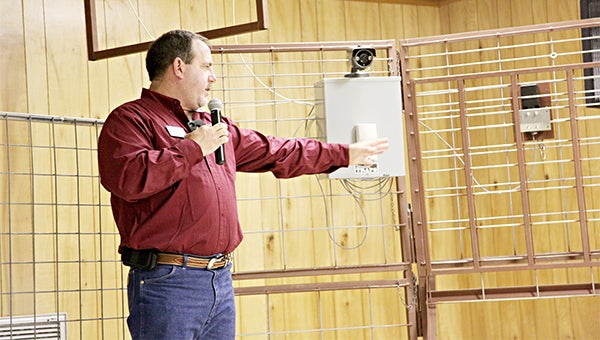Hogs threaten state economy
Published 12:00 am Sunday, February 1, 2015

WILD HOGS: Mississippi State University Extension Service Wildlife Specialist Cliff Covington speaks to the Warren County Forestry Association about wild hogs Thursday during their annual banquet at International Paper in Redwood.
Perhaps the biggest threat to Mississippi tromps around on four legs and wallows in the mud. It is a powerful, intelligent and seemingly indestructible beast that left unbridled could ruin the Magnolia State’s agricultural and hunting economy.
Wild hogs are rooting up crops, chomping down trees, destroying levees, and spreading disease as they reproduce at an alarming rate, Cliff Covington, Mississippi State University Extension Service Wildlife Specialist for South Mississippi, told the Warren County Forestry Association during their annual banquet this week at International Paper in Redwood.
“If it’s a longleaf pine seedling in the pasture, that’s what they’re going to eat. If it’s a baby fawn or calf, that’s what they’ll eat. They’re like a goat on steroids. They will literally eat anything,” said Covington, who is a Claiborne County native.
From the Gulf Coast to the Tennessee state line, wild hogs cause millions of dollars in damage each year, and nationally they are blamed for $1.5 billion in damages annually, he said while flipping though a slideshow of hog ruts in forests, farmlands and Vicksburg National Military Park.
“As you can see, we’ve got hog problems across the state,” he said.
The state is doing everything it can to eradicate the nuisance animals — even resorting to shooting them with high-powered automatic rifles mounted on helicopters.
Yet, little seems to be working to slow the damage from the swine that are swallowing up the South.
Hunting takes a hit
Trapping, Covington said, is the most efficient way of disposing of nuisance hogs, but even it isn’t 100 percent reliable.
Jimmy Gouras has trapped 173 hogs on his property in Claiborne County in the past three years, yet the damage is still constant.
“I have planted about 15 acres of corn for the deer and turkeys and expected that a hog would eat a little bit of it. When that corn started making ears, those hogs knocked down every stalk of corn in that field,” Gouras said.
It’s been more than three months since Gouras has trapped a hog, and it looks like the older hogs on his property have gotten wise to his plan.
“I don’t ever see them. I rarely ever see one in the daylight,” he said.
While the boars and sows love to pick through the corn patch, they tend to prefer acorns, he said. Three years ago, Gouras planted 8,000 hardwood trees, and hogs have eaten nearly every one.
“If I thought I could sell this place and go somewhere else where there’s not hogs, I might consider it. But hogs are everywhere,” he said.
Robert Murphy, owner of Miller’s Tire Mart in Vicksburg, said he’s concerned about how hog populations have impacted the deer on his property in Claiborne County. For most of the year, deer and pigs compete for about 25 percent of their diet, but in the fall, 50 percent of their diet overlaps.
“Those hogs are competing with deer for habitat. I can live with everything else except they are driving the body weights of the deer down,” he said.
At Tara Wildlife in northern Warren County, about a dozen pigs have been trapped since October.
“It’s very limited but we’re probably one of the rare ones around,” said Mark Bowen, sales and marketing director for Tara. “We’re out in the woods so much, they’re not out there for an extended time without us finding out about it.”
If deer begin to die off because of hog overpopulation it could be devastating for the state’s hunting tourism, Murphy said. A 2006 study by the U.S. Department of the Interior found that hunting, angling and wildlife watching was a $1.2 billion industry for Mississippi.
“They don’t come here to hog hunt. They come here to deer hunt,” Murphy said. “It’s a terrible state problem.”
Deer hunters in Mississippi killed 52,000 pigs in incidental harvests in 2011, the same year Louisiana reached a sour milestone.
“They have killed more wild pigs during deer season than they have deer. They’ve got a pretty bad problem over there,” Covington said.
MSU officials are also planning to study the effects on rising hog populations on turkeys.
The prolific pig
Getting rid of wild hogs can seem virtually impossible because of how quickly they breed, Covington said.
Pigs produce a large litter two or three times a year and reach reproductive maturity by 6 months old. Typically four piglets survive into adulthood.
“When they are very little is the only time they have any predators. Once they get up to any size, the only predator that exists is man,” Covington said.
And man can’t keep up.
Tom Lee who runs Hintson Farms on Mississippi 3 between International Paper and the Yazoo County line says he’s killed more than 100 hogs since October.
“We have traps, we hunt them, we thermal image hunt them at night. We basically hunt them year round trying to control them,” Lee said.
The hogs are after his agricultural products — corn, soybeans and milo.
“They destroy more than they eat. They knock more plants down than they eat up,” he said.
Killing a pig or two does virtually nothing to control the population. Even killing half a sounder of pigs makes very little difference, Covington said. At least 70 percent of the population must be killed every year in order to maintain current levels.
“If you have a piece of property that has 100 pigs on it and go in and kill 70 pigs every year for 10 years, you’re still going to have 100 pigs when you get through with it,” Covington said.
Because of this high rate of reproduction, states like Texas and Oklahoma, which have had major pig infestation for decades, have given up on ever getting rid of the critters and instead focus on mitigating damage.
Left uncontrolled a pair of hogs can turn into 43 hungry boars and sows in five years. In 10 years, that pair of pigs can turn into more than 600. In 20 years, those two hogs can easily become 122,000.
“That’s on a general reproductive level with an average of four pigs surviving per litter,” Covington said.
Pigs can also survive in almost any climate — swamps, plains, forest — and are prevalent in 46 states and have reached southern Canada where in the winter they burrow into snowdrifts.
With thousands of hogs wallowing around across the state damage to farm and timberland is astounding. In 2011, pigs also caused hundreds of thousands of dollars worth of damage to the state’s levee system during the historic Mississippi River Flood.
“People don’t understand the economic impact they’re causing because of their rooting around and the erosion in the hills,” Lee said.
A swine solution
A wild pig will eat about 10 pounds of food — meat and vegetation — each day, Covington said. That’s about a third to twice as much as white tail deer, according to the North American White Tail Association.
Ten pounds might not seem like much, Covington said, but it can be a field of freshly sewn corn or more pine seedlings than a forester can plant in a day.
“They can eat up to 1,000 longleaf pine seedlings per day,” he said.
Because of the high consumption rate, Anderson-Tully officials have asked Covington to investigate the impact feral pigs have on hardwood regeneration. There are 60 to 80 acorns per pound for most oak species, meaning hogs can gobble up as many as 800 potential trees each per day.
Some farmers in the South Delta have resorted to surrounding their crops with electric fences in an attempt to keeps pigs out. It doesn’t always work.
Researchers across the country are looking at developing a deadly substance that pigs find delicious. The problem is it can’t be fatal to other animals. One substance is showing promise in a Louisiana State University study, but the program has been delayed multiple times as trials showed mixed results, Covington said.
For Gouras, a perfect poison seems to be the only solution.
“I don’t think you’ll ever control them with a rifle. I don’t think we’ll ever control them period until they come up with something specific to hogs to eradicate them. There aren’t enough guns out there to get rid of these hogs or to make a dent in the population,” Gouras said.
If poison isn’t an option, Lee said, perhaps a, long-lasting, easy-to-administer contraceptive can be produced, Hall said.
“We’ve got poisons but the problem is they kill black bears,” Hall said.
Black bears are a protected species in Mississippi and can also complicate hunting. At night when hogs are most prevalent at food plots, Covington said, it is difficult for a hunter to distinguish a pig from a black bear, even if the hunter is using thermal imaging.
History of hogs
Pigs are an invasive species whose rise to porky power in North America began centuries ago.
The first swine arrived on the continent in 1492 with Christopher Columbus who brought them as a food source. Hernando DeSoto also brought hogs on his tour of what is now the Southeast United States in 1539.
Though hogs brought by the long-dead explorers escaped and bred, Mississippi’s big pig problem is a much newer, and the source is twofold, Covington said.
Most wild pigs in the country are descended from a single farm at Hooper Ball, N.C. that began breeding the animals in the early 20th century.
In the late 1960s, the Mississippi officials introduced pigs into the George F. Henneberry Game Preserve at the Copiah-Claiborne county line, Covington said.
“The Game and Fish Commission bought in some pigs from Hooper Ball and bred them there. They built pens and bred them up until they had close to 100 pigs, then took breeding pairs and turned them loose all over the state with the intention to let the hunters have something to hunt in the summertime,” Covington said.
Leftover hogs from the experiment were released in Bruinsburg, Covington said.
The experiment, in hindsight, was a horrible mistake, but overzealous hunters are also to blame.
“Hunting — I try not to use that word a whole lot. I prefer shooting. You don’t want to incentivize wild pigs and you don’t want to treat them as a game animal. As soon as you do that your population gets out of control,” Covington said.
In the late 1980s, the Game and Fish Commission plan had worked too well, and hunters wanted another prey. Rather than killing hogs, hunters were trapping and releasing them in other parts of the state. So rather than helping eliminate hogs, legitimizing their hunting for sport, actually makes the problem worse, Covington said.
“Don’t ever haul a live hog up and down the road,” he said.





